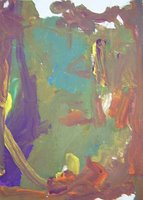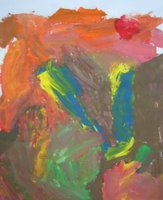 Children love to paint. Painting is messy, adventurous, and bold. One uses a brush instead of a fine-pointed writing instrument; strokes are broad and free. In fact, it's the process of painting that is important for young children; it's the playfulness; the motion of the brush dabbing and swirling pigment. The child may attempt to paint a picture, or she may just play with color and design. Painting is great fun!
Children love to paint. Painting is messy, adventurous, and bold. One uses a brush instead of a fine-pointed writing instrument; strokes are broad and free. In fact, it's the process of painting that is important for young children; it's the playfulness; the motion of the brush dabbing and swirling pigment. The child may attempt to paint a picture, or she may just play with color and design. Painting is great fun!The availability of easels, smocks, paint palettes, and a variety of brushes allows young children to recognize that they are viewed as trusted, capable artists. At the Blackfoot Art Center, here is how we prepare an open-ended painting activity for four- to six-year-olds:
Materials:
Heavy sketching, drawing or watercolor paper 11 x 14 or larger
Table or child height floor easle
Flat, smooth board such as masonite or sanded plywood (larger than the paper)
Masking tape
Tempera paints, each color in its own covered plastic container
Palettes (we use old pie tins)
Assorted brushes
Large water container
Plastic knives (palette knives)
Paint smock
Paper towels
Newspaper
What to do:
Spread newspapers on the table. Place water container on the table.
Tape all four sides of the paper to the board. (The paper will wrinkle when painted, but will flatten back out when dry.) Place the board on the easle, which should be set at eye-level when the child is standing.
Scoop the primary paint colors (red, yellow, and blue) onto the child's palette, and briefly explain how to create new colors by mixing them together using the plastic knife or a brush. Also show the child how to clean the paint brush between colors and dab off excess water on a folded paper towel. Provide any additional colors that the child requests, such as purple, orange, or green.
Now, just let your child paint!

The painting will likely start out timidly with small, distinct areas of color here and there. Then, as the child become more adventurous, colors will begin to fill the paper in great strokes and swirls. This is often accompanied by verbal cues, such as "Here's some green!" or "Whoa, look at all this pink!." Eventually, most of the colors will likely be blended together to make a nice army green.
Most of your youngster's first works will consist of random strokes of color that represent the playful experience of painting, such as in these pieces by two 4-year-olds, Billy and McKenzie. Then at a certain point (only the child knows exactly when), the painting will be "done." If the child wants
 to try another, carefully remove the completed work from the board and set it aside to dry. Wipe the board down, and tape on another piece of paper. This time your child may do exactly the same type of thing, or he may attempt to paint apply color in a specific design or even a representational piece.
to try another, carefully remove the completed work from the board and set it aside to dry. Wipe the board down, and tape on another piece of paper. This time your child may do exactly the same type of thing, or he may attempt to paint apply color in a specific design or even a representational piece.Below, 4-year-old Erik's first painting (left) was obviously an experiment in playful design and color-mixing. The second painting (center) was a bit more deliberate in design and color selection. Erik's final painting illustrates planning in both the use of color and subject representation. In fact, he entitled this piece "Beehive in a Tree."



Isn't it amazing what young children can do when given encouragement and the proper materials?
No comments:
Post a Comment